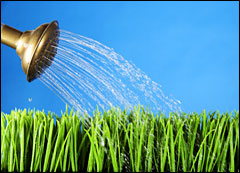Dear Umbra,
Thanks for your good advice about water conservation. You failed to mention the largest (unnecessary) water user in most U.S. homes: outdoor plant watering. While Grist readers may be eco-wise enough not to water their plants, nor even entertain the possibility of managing a green lawn, there may still be a few closet waterers out there. The solution: choose the right plant for the right location; water the plant to get it established; after the first couple seasons, let only the fittest survive. If you’re not that ruthless, use a rain barrel to capture what nature supplies and use as needed.
Cindy Shea
Chapel Hill, N.C.
Dearest Cindy,
Right. I completely failed to mention outdoor water use, and in fact have never written about water conservation in the yard. Much to my shock. Rest assured, out of our many readers, a few may be enlightened by your letter.

A little bit should go a long way.
Photo: iStockphoto
As Cindy so accurately noted, much of the water use in yards is unnecessary, and most household water use is in the yard. Yes, a catchy percentile would be good here, but the amount of outdoor water use as a percentage of household use will depend on where you live, ranging from about seven percent to 70 percent. However, a plant-filled yard is still a good thing — and let me go over the reasons why, because if anyone is inspired to pave their front yard with pink and white bricks to avoid water use, like that house I saw once in California, I wish to deter them.
A plant-filled yard is good because root-filled soil is porous and absorbs rain and runoff, filtering it and participating heartily in the water cycle. Pavement, plastic, roofs, and pink and white bricks are impervious surfaces from which water runs off downhill and joins other runoff, amassing a mass and momentum, becoming emboldened to various delinquent acts such as eroding banks, washing out wildlife habitat, clogging storm drains, causing flooding in agricultural areas. Impervious surfaces are a serious problem, and when we nourish a healthy garden — even a healthy lawn! — we help to mitigate the problem our roads and roofs cause. A nice yard will also help cool an urban landscape, whereas a nice pavement will retain and radiate heat.
But if one has such a fabulous thing as a yard, whatever is in the yard is probably watered. Many persons use water to keep grass and other geographically inappropriate plants green during dry months, to nourish young perennial plants while they become “established,” and to help their vegetables grow.
Cindy’s four-point system is an excellent one, and I have only a few comments. On choosing the right plant for the right location: a plant happy in its location will need less nutritional and aqueous help from its gardener. Although native plants can be a perfect choice, defining “native” can be tricky, and non-native plants can sometimes be appropriate. So, how do we know what plants are right for a location, when landscaping seems like an esoteric mystical art? Cooperative extension! Master gardeners! The library! The newspaper! Experimentation! The neighbors!
Point two: if a plant is a perennial, water it for a few years so it can establish a root structure; then, if you have put a low-water plant in the right location, it should be fine without your hose. Point three — let the plants die if they can’t handle it — is only for those who are willing to let plants die, and some people are just going to haul out the hose in pity for the plants they love, so I’ll tell you how to water properly in a second. But one more point: Reduce your lawn. Slowly take away your lawn if you find you can’t bear not watering it, chemically fertilizing it, or using a gas mower. With your leftover lawn, water deeply and less often (again, cooperative extension and master gardeners can give you lawn-watering tips for your area), and do all those lawn-tending tasks like aerating and autumnal top dressing with compost.
Watering is best done in the evening or very early morning. Evaporation is an obvious reason for this. During hot, sunny weather, water evaporates into the air as it shoots out of a hose, even a drip hose, and the water left on the soil surface will also dry quickly. Capillary action may even draw water up out of the soil to be dried on the surface during hot days. Speaking of drip hoses, surface-delivered water is almost always preferable to air-delivered water (sprinklers and hoses), for the same evaporative reasons. Evening and early morning (you know, 3 a.m. type of early) are easy times to water if you have a timer and hose system. If you have no idea about the wide variety of drip irrigation and catchment systems (rain barrels) available for the home gardener, please peruse DripWorks to get yourself started (remember, I’m vendor-agnostic). Happy less watering, everyone.
Parchedly,
Umbra


